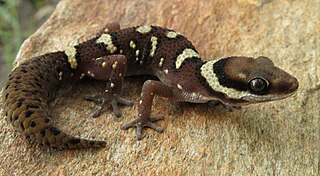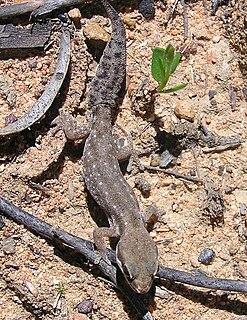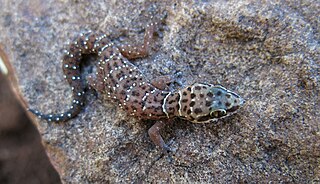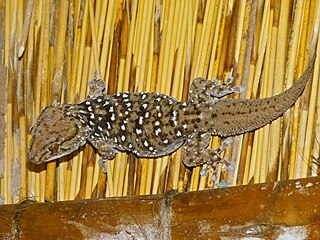
Pachydactylus is a genus of insectivorous geckos, lizards in the family Gekkonidae. The genus is endemic to Africa, and member species are commonly known as thick-toed geckos.

Ptenopus is a small genus of lizards, known commonly as barking geckos, in the family Gekkonidae. The genus is endemic to Southern Africa. There are only three described species in this genus.
Peringuey's leaf-toed gecko, also known commonly as the salt marsh gecko, is a species of lizard in the family Gekkonidae. The species is endemic to South Africa.

The Cape dwarf gecko ('lygodactylus' = 'flexible fingers') is a species of dwarf gecko found in the woodlands and forests of central and southern Africa. It also occurs commonly in towns and cities and is sometimes kept as a pet.
The Cape file snake is a species of large, non-venomous snake endemic to Africa, belonging to the family Lamprophiidae.

Pachydactylus geitje, also known as the ocellated gecko, ocellated thick-toed gecko or Cradock thick-toed gecko, is a tiny species of thick-toed gecko, which is indigenous to the Western Cape of South Africa.

The Biodiversity of Cape Town is the variety and variability of life within the geographical extent of the City of Cape Town metropolitan municipality, excluding the Prince Edward Islands. The terrestrial vegetation is particularly diverse and much of it is endemic to the city and its vicinity. Terrestrial and freshwater animal life is heavily impacted by urban development and habitat degradation. Marine life of the waters immediately adjacent to the city along the Cape Peninsula and in False Bay is also diverse, and while also impacted by human activity, the habitats are relatively intact.
Vivian Frederick Maynard FitzSimons, born in Pietermaritzburg, was a notable herpetologist in South Africa. Also, he contributed to the collection of spermatophyte samples for the National Herbarium which has become part of the South African National Biodiversity Institute at the Pretoria National Botanical Garden. In 1937, together with Anna Amelia Obermeyer, he collected some of the earliest plant specimens from the Eastern Highlands of Rhodesia.
Pachydactylus robertsi, commonly known as the large-scaled gecko, shielded thick-toed gecko, or Rauhschuppen-Dickfingergecko in German, is an African species of gecko.
Goggia rupicola, also known as the Namaqua dwarf leaf-toed gecko or the Namaqua pygmy gecko, is a southern African leaf-toed gecko first described by Vivian FitzSimons from a specimen collected on the 23 August 1937 where it was found in cracks of rocks of small outcrops in the arid Namakwaland in South Africa and Namibia.

Pachydactylus vansoni, commonly known as Van Son's gecko or Van Son's thick-toed gecko, is a species of lizard in the family Gekkonidae. The species is endemic to Southern Africa.

Turner's thick-toed gecko is a species of lizard in the family Gekkonidae. The species is endemic to southern Africa.

Chondrodactylus angulifer, also known as the common giant ground gecko, the South African ground gecko, or the Namib sand gecko, is a species of gecko, a lizard in the family Gekkonidae. The species is endemic to southern Africa.
The Cape Cross thick-toed gecko, also known commonly as Koch's gecko and Koch's thick-toed gecko, is a species of gecko, a lizard in the family Gekkonidae. The species is endemic to southern Africa.
Pachydactylus barnardi, also known commonly as Barnard's rough gecko or Barnard's thick-toed gecko, is a species of lizard in the family Gekkonidae. The species is indigenous to Southern Africa.
Pachydactylus haackei, also known commonly as Haacke's gecko or Haacke's thick-toed gecko, is a species of lizard in the family Gekkonidae. The species is endemic to Southern Africa.
Pachydactylus scherzi is a species of lizard in the family Gekkonidae. The species is native to Southern Africa.
Werner's thick-toed gecko is a species of lizard in the family Gekkonidae. The species is endemic to Namibia.









